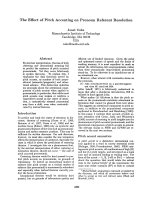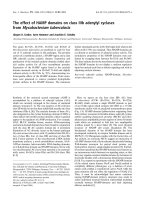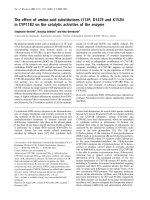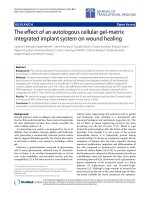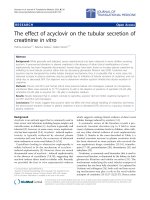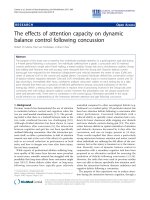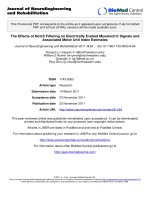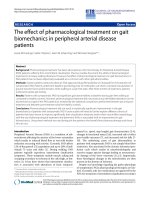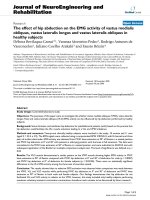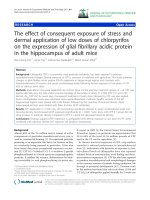báo cáo hóa học:" The effect of muscle contusion on cortical bone and muscle perfusion following reamed, intramedullary nailing: a novel canine tibia fracture model" potx
Bạn đang xem bản rút gọn của tài liệu. Xem và tải ngay bản đầy đủ của tài liệu tại đây (425.81 KB, 8 trang )
RESEARC H ARTIC L E Open Access
The effect of muscle contusion on cortical bone
and muscle perfusion following reamed,
intramedullary nailing: a novel canine
tibia fracture model
Henry Koo
1
, Thomas Hupel
2
, Rad Zdero
3,4*
, Alexei Tov
4
, Emil H Schemitsch
4,5
Abstract
Background: Management of tibial fractures associated with soft tissue injury remains controversial. Previous
studies have assessed perfusion of the fractured tib ia and surrounding soft tissues in the setting of a normal soft
tissue envelope. The purpose of this study was to determine the effects of muscle contusion on blood flow to the
tibial cortex and muscle during reamed, intramedullary nailing of a tibial fracture.
Methods: Eleven adult canines were distributed into two groups, Contusion or No-Contusion. The left tibia of each
canine underwent segmental osteotomy followed by limited reaming and locked intramedullary nailing. Six of the
11 canines had the anterior muscle compartment contused in a standardized fashion. Laser doppler flowmetry was
used to measure cortical bone and muscle perfusion during the index procedure and at 11 weeks post-operatively.
Results: Following a standardized contusion, muscle perfusion in the Contusion group was higher compared to
the No-Con tusion group at post-osteotomy and post-reaming (p < 0.05). Bone perfusion decreased to a larger
extent in the Contusion group compared to the No-Contusion group following osteotomy (p < 0.05), and the
difference in bone perfusion between the two groups remained significant throughout the entire procedure
(p < 0.05). At 11 weeks, muscle perfusion was similar in both groups (p > 0.05). There was a sustained decrease in
overall bone perfusion in the Contusion group at 11 weeks, compared to the No-Contusion group (p < 0.05).
Conclusions: Injury to the soft tissue envelope may have some deleterious effects on intraosseous circulation. This
could have some influence on the fixation method for tibia fractures linked with significant soft tissue injury.
Background
Intramedullary nailing is the most widely used form of
fixation for most open femoral and tibial shaft frac-
tures [1-4]. Nailing allows for maintenance of bone
length and alignment while reducing soft tissue disrup-
tion, relative ease of implant insertion, preservation of
hematoma associated with fracture, and load sharing
between the injured host bone and the inserted nail
[5,6]. Healing rates for femur fractures treated with
intramedullary nailing have been reported to be
between 90 and 95% [5].
Reaming of the intramedullary canal to rec eive a nail
in order to treat femoral and tibial shaft fractures asso-
ciated with severe soft tissue injury remains controver-
sial, since there are a number of negative consequences
associated with reaming. Although intramedullar y ream-
ing allows the passage of a larger diameter nail, thereby
providing more biomechanical stability because of better
bone on na il contact [7-10], there are well-recognized
deleterious effects of standard reaming on cortical bone
blood perfusion [4,11-17]. However, it should be noted
that cortical blood flow may be restored some weeks
later. Reaming can also compromise the endosteal circu-
lation when the surrounding soft tissue envelope
becomes the principle source of blood supply for frac-
ture healing [4,18-23]. Previous studies by some of the
* Correspondence:
3
Department of Mechanical and Industrial Engineering, Ryerson University,
Toronto, ON, Canada
Full list of author information is available at the end of the article
Koo et al. Journal of Orthopaedic Surgery and Research 2010, 5:89
/>© 2010 Ko o et al; licensee BioMed Central Ltd. This is an Open Access article distributed under the te rms of the Creative Commons
Attribution License (http://crea tivecommons.org/licenses/by/2.0), which permits unrestricted use, distribu tion, and reproduction in
any medium, provided the original work is properly cited.
current authors have demonstrated the effects of ream-
ing and canal fill on the blood flow to the tibia and its
surrounding muscle [24,25]. Limited reaming, though,
may be performed to minimize this effect [26]. However,
these studies were done using a normal soft tissue
envelope and are not representative of most clinical sce-
narios that might be encounter ed, highlighting the need
foraninvestigationonreamingwithinaninjuredsoft
tissue envelope.
The purpose of this study, therefore, was to evaluate
the effects of a standardized muscle contusion on blood
flow to the tibia and its surrounding muscle following
limited, intramedullary reaming and nail insertion of a
segmental tibia fracture in a canine. In addition, by creat-
ing a reproducible standardized muscle contusion model,
further studies could then be performed to evaluate other
variables in this setting. It was hypothesized that bone
and muscle blood perfusion would decrease due to tibial
reaming and nailing to repair a segmental tibial fracture
in the presence of a standardized muscle contusion.
Methods
Preoperative Period
Eleven adult mongrel dogs were used, each having a
mass of least 24 kg. Each dog was conditioned into
good health for a minimum of 21 days. Radiographs of
both limbs were obtained preoperatively to ensure skele-
tal maturity and to measure canal diameter. This experi-
mental protocol was approved by the animal care
committee at the authors’ institution. The initial study
design was comprised of two groups of 6 animals each,
however, one animal died prematurely and could not be
included in the study.
Experimental Groups
The 11 canines were distributed into two operative
groups with no statistical difference in canal diameter
between them. Although randomized allocation may be
considered ideal, the pres ent small sample size required
non-randomized distribution to ensure equivalency
between test gr oups. The Contusion group consisted of
reamed intramedullary nailing (6.5 mm × 170 mm nail
with reaming to 7.0 mm) with a standardized muscle
contusion to the anterior muscle compartment (n = 6).
The No-Contusion group consisted of reamed intrame-
dullary nailing (6.5 mm × 170 mm nail with reaming to
7.0 mm) without muscle contusion (n = 5).
Surgical Technique
Amoxicillin trihydrate/C lavulanate potassium (15 mg/kg
PO BID) was given to the animals 48 hours prior to
each surgical procedure. After sedation with subcuta-
neous Atropine sulfate (0.05 mg/kg) and Aceprom azine
maleate (0.03 mg/kg), anaesthesia was induced with
intravenous Thiopental sodium (12.5 mg/kg), and Oxy-
morphone hydrochloride (0.05 mg/kg). After endotra-
cheal intubation, general inhalational anesthesia was
maintained with Halothane (1 .5%), Nitrous Oxide (33%),
and Oxygen (65.5%). Prophylactic Cefazolin (1 g IV) was
administered at the beginning of the procedure and
every two hours during the operation. Fluid require-
ments were maintained by intravenous Lactated Ringer’s
solution at 30 cc/kg/hr.
The left hindlimb of each animal was shaved,
scrubbed, and prepped using 4% Chlorhexidine gluco-
nate and 10% Povidone-iodine topical solution. No tour-
niquet or traction was used. The animals were place d in
the supine position in a trough. A craniolateral approach
to the tibia was made, extending from the lateral
femoral condyle to the hock joint (ankle joint). The
muscle fascia was incised. The muscle was then
reflected, and the periosteum was elevated off the ante-
rolateral aspect of the tibia. Blood flow to the m uscle
and bone were taken using a PF3 Laser Doppler Flow-
meter (Perimed, Jarfalla, Sweden) with ± 10% accuracy
and ± 3% precision in perfusion units. Measurements
were taken of the cranial tibialis (tibialis anterior) mus-
cle and the cortical bone at pre-specified locations,
namely, 5.0, 8.5, and 15.0 cm distal to the lateral tibial
plateau. The values were then aver aged, as done in pre-
vious studies on canines by some of the current authors
[24,25]. The measurem ents were taken by placing the
laser doppler flowmetry probe on the surface of the
muscle or bone until a stable reading was obtained. Per-
fusion measurements were then recorded for 60 seconds
using a personal computer (Samsung, Notemaster, 486P;
Samsung SDS America Inc., San Jose, CA, USA) and
Perisoft software (Perimed, Jarfalla, Sweden).
Six dogs had the anterior muscle compartment con-
tused using two aluminum discs, each with an area of
19 cm
2
, mounted on a C-clamp (Figure 1). A uniform
force of 4 00 N was applied for 20 s econds. A calibrated
strain gage meter (Infinity C Strain Gage Meter, New-
port Electronics Inc., Santa Ana, CA, USA) quantified
the force. The entire anterior compartment was con-
tused at the level of the osteotomy. The c ontusion was
performed prior to osteotomy. The application of contu-
sion load using the C-clamp apparatus was performed
identically for all tests. Thus, the relative effect of the
C-clamp was the same for each test group.
Two osteotomies were performed to create a 2.5 cm
mid-diaphyseal bone segment, as done previously by
some of the authors in canine tibial fracture studies
[24,25]. The proximal osteotomy site was 8.0 cm distal to
the lateral tibial plateau. Complete sub periosteal dissec-
tion was carried out on the 2.5 cm segment to remove it
from the surgical field. This devascularized segment was
then re-introduced and reduced anatomically. The canal
Koo et al. Journal of Orthopaedic Surgery and Research 2010, 5:89
/>Page 2 of 8
was sequentially reamed to 7.0 mm. The fra cture was
then stabilized with a custom-designed, solid 6.5 mm
intramedullary nail made of 316L stainless steel (Synthes
Canada, Mississauga, ON, Canada) locked proximally and
distally with 2.7 mm screws.
In a standardized fashion from animal to animal,
laser doppler flowmetry measurements were taken at
ambient room temperatur e during the 2-hour surgical
procedure, while the animal was anaesthetized, at four
time intervals (pre-muscle contusion, post-osteotomy,
post-reaming, and post-nailing) at the three sites pre-
viously specified. The values were then averaged, as
done in prior studies on canines by some of the cur-
rent authors [24,25]. The wound was closed in layers.
The muscle fascia w as left open to prevent the devel-
opment of compartment syndrome. Subcutaneous tis-
sue and skin were closed primarily. Sterile
compression dressing was applied to the limb. During
the perioperative period, the dogs were monitored at
frequent intervals.
Post-operative Period
Post-operative care included prophylactic Amo xicillin
trihydrate/Clavulanate potassium (15 mg/kg PO BID for
7 days) and analgesia with Buprenorphine hydrochloride
(0.02 mg/kg SC OD for 2 days). Wounds were moni-
tored daily. The dogs were able to fully weight bear
immediately. Standard anterop osterior and lateral radio-
graphs of the left tibiae were taken at three-week inter-
vals to assess fracture healing. Prior to radiography,
sedation was provided using intravenous Oxymorphone
hydrochloride (0.05 mg/kg).
Week 11 Procedure
At 11 w eeks post-operatively, general a naesthesia was
induced according to the previously described protocol.
A repeat craniolateral incision was made through the
initial surgical incision. Final laser doppler flowmetry
measurements at the sites previously specified were
taken of the cortical bone and muscle. The animals
were then euthanised with an overdose of intravenous
Thiopental sodium (500 mg) and Potassium chloride.
Bilateral tibiae were then harvested for radiographic ana-
lysis. This 11-week time point was chosen in order to be
well beyond the point of bone union at the fract ure site,
which is known to begin at about 6 weeks post-opera-
tively [27,28].
Statistical Analysis
A similar approach to the statistical analysis described
here was used in prior related studies on canines by
some of the current authors [24,25]. Overall muscle and
cortical blood flow were calculated as the average laser
doppler flowmetry reading at the three measurement
sites, namely, 5.0, 8.5, and 15.0 cm distal to the lateral
tibial plateau. All perfusion values from laser doppler
flowmetrywerenormalizedbydividingaveragevalues
by the baseline average value for both muscle and bone
scenarios. Statistical comparisons were made between
No-Contusion and Contusion groups for overall and
segmental measurements at each time using paired t-
tests with a p < 0.05 significance level. However, for
subsequent comparisons between each time point with
respect to baseline for each of the two muscl e condition
groups, non-paired t-tests were employed with an
adjusted Bonferroni significance level of p < 0.01 in
order to avoid ty pe I error due to multiple comparisons.
This adjusted value was calculated by dividing the
p-valuefora95%confidenceintervalbythenumberof
time points compared, i.e., p-value (Bonferroni) =
p-value for 95% confidence interval/number of time
points = 0.05/5 = 0.01.
Post Hoc Power Analysis
A post hoc power analysis was performed to assess
whether 5 specimens (No-Contusion) and 6 specimens
(Contusion) per group were adequate to detect all statis-
tical differences that might actually exist between these
two contusion conditions, i.e. to avoid type II error , at a
given time point. The computation for pow er using a
one-tailed test was done at the 11-week time point for
both muscle perfusion (overall) and bone perfusion
(intercalary segment), since this most closely represents
the lo ng-term post-operative situat ion and is ultimately
of interest to both clinicians and patients.
Figure 1 Muscle contusion. Intraoper ative photograph of the
anterior muscle compartment undergoing contusion prior to
osteotomy using two circular aluminum discs, each with an area of
19 cm
2
mounted to the C-clamp. A 400 N force was applied for 20
sec. A strain gage meter was attached to the C-clamp to monitor
the force reading.
Koo et al. Journal of Orthopaedic Surgery and Research 2010, 5:89
/>Page 3 of 8
Results
Preoperative Data
There were no differences between the canal diameters
of the two groups (p = 0.17). Average canal diameters
were 8.8 ± 1.8 mm and 7.5 ± 1.0 mm for the No-Contu-
sion and Contusion groups, respectively.
Initial Intraoperative Data
Immediately following sta ndardized contusion, overall
muscleperfusionintheContusion group was higher
compared to the No-Contusion group at post-osteotomy
and post-reaming (Figure 2). Overall muscle perfusion
increased nearly two-fold in the Contusion group at
post-osteotomy compared to baseline.
Site-specific analysis revealed that most of this differ-
ence was found within the injury zone, where t he mus-
cle perfusion was found to be nearly three times higher
than the baseline value in the Contusion group (Figure
3). In the Contusion group, there was a statistically sig-
nificant decrease in the muscle perfusion following
reaming with respect to baseline. There remained a bor-
derline significant difference between the two groups
following reaming (p = 0.05). Towards the end of the
initial procedure (post-nailing), the increase in muscle
perfusion in the Contusion group returned to nearly
normal levels. In the No-Contusion group, muscle per-
fusion returned to baseline value. There was no longer
any significant difference in muscle perfusion between
the two groups at the end of the procedure (p = 0.45),
which had both returned to baseline values.
Regarding overall tibial blood flow, all procedures in
both groups were statistically different than baseline,
except for 11 weeks in the No-Contusion group (p =
0.374) (Figure 4). Moreover, th ere was a statistically sig-
nificant decrease in the overall bone perfusion follow ing
osteotomy in both groups (Figure 4), which was mainly
due to the zero value of the intercalary segment (Fig-
ure 5). However, bone perfusion decreased to a larger
extent in the Contusion group following osteotomy
compared to the No-Contusion group. The difference
between the two groups remained significant throughout
the entire procedure. With regard to bone perfusion in
OVERALL MUSCLE PERFUSION
0
0.5
1
1.5
2
2.5
BASELINE POST
OSTEOTOMY
POST REAMING POST NAILING 11 WEEKS
TIME
NORMALIZED PERFUSION
WITH CONTUSION
NO CONTUSION
*
*
p<0.05 (between contusion groups)
# p<0.01 (times compared to baseline)
*
#
#
Figure 2 Overall muscle perfusion.Valuesforeachtimepoint
were the average reading from the three different laser doppler
flowmetry measurement locations. The values at each time point
were all normalized by dividing by the average value at baseline.
The error bars indicate one standard error of the mean. Statistically
significant differences between Contusion and No-Contusion groups
are indicated (*, p < 0.05). Statistical differences present when
comparing procedures at each time to baseline only occurred in
the Contusion group (#, p < 0.01).
MUSCLE PERFUSION (ZONE OF INJURY)
0
0.5
1
1.5
2
2.5
3
3.5
BASELINE POST
OSTEOTOMY
POST
REAMING
POST NAILING 11 WEEKS
TIME
NORMALIZED PERFUSIO
N
WITH CONTUSION
NO CONTUSION
*
$ p=0.05 (between contusion groups)
p<0.01 (between contusion groups)
# p<0.01 (times compared to baseline)
*
$
#
#
Figure 3 Muscle perfusion within the zone of injury.Valuesfor
each time point were the average reading from the three different
laser doppler flowmetry measurement locations. The values at each
time point were all normalized by dividing by the average value at
baseline. The error bars indicate one standard error of the mean.
Statistically significant differences between Contusion and No-
Contusion groups are indicated (*, p < 0.01). A borderline statistical
difference was found at post-reaming ($, p = 0.05). Statistical
differences existed when comparing procedures at each time to
baseline only in the Contusion group (#, p < 0.01).
OVERALL TIBIAL BLOOD FLOW
0
0.2
0.4
0.6
0.8
1
1.2
BASELINE POST
OSTEOTOMY
POST
REAMING
POST NAILING 11 WEEKS
TIME
NORMALIZED PERFUSIO
N
WITH CONTUSION
NO CONTUSION
*
*
*
*
p<0.05 (between contusion groups)
# p=0.374 (11 weeks compared to baseline)
p<0.01 (all other times compared to baseline)
*
#
Figure 4 Overall cortical bone blood flow of the tibia. Values for
each time point were the average reading from the three different
laser doppler flowmetry measurement locations. The values at each
time point were all normalized by dividing by the average value at
baseline. The error bars indicate one standard error of the mean.
Statistically significant differences between Contusion and No-
Contusion groups are indicated (*, p < 0.05). All procedures at each
time compared to baseline were statistically significant (p < 0.01),
except for 11 weeks in the No-Contusion group (#, p = 0.374).
Koo et al. Journal of Orthopaedic Surgery and Research 2010, 5:89
/>Page 4 of 8
the intercalary segment, all procedures were statist ically
different than baseline, except for 11 weeks in the No-
Contusion group (p = 0.49) (Figure 5).
Week 11 Data
There were no wound infections. All tibiae were hea led
clinically and radiographically at the time of harvesting.
Muscle perfusion overall and in the zone of injury was
statistically the same i n both groups at 11 weeks, the
level not being statistically different than baseline
(Figure 2 and 3). Overall bone perfusion was greater in
the No-Contusion group at 11 weeks, by which time it
had returned to baseline levels (Figure 4). S ite-specific
analysis showed t hat the intercalary bone seg ment
showed no statistical diff erence between the Contusion
and No-Contusion groups at 11 weeks, although the
No-Contusion group had returned to baseline levels by
week 11 (Figure 5).
Post Hoc Power Analysis
The post hoc power analysis at the 11- week mark f or
the muscle perfus ion (overall) yielded 24% and for bone
perfusion (intercalary segment) showed 38%. A high-
powered statistical design is normally considered to be
80% or higher. Consequently, the number of specimens
was not adequate to detect all statistical differences
present.
Discussion
Treatment of tibial shaft fractures associated with signif-
icant s oft tissue injury remains challenging. This study
attempted to simulate a high-energy i njury resulting in
an unstable fracture pattern with significant soft tissue
injury. Therefore, a segmental fracture with a standar-
dized muscle contusion was used. Reaming was per-
formed so that its effects could be evaluated within an
injured soft tissue envelope. Limited reaming was used
because of the well-known detrimental effects of stan-
dard reaming [4,11-23]. Laser doppler flowmetry was
employed to measure bone and muscle perfusion. This
technique allows instantaneous blood flow measure-
ments in vivo without the sacrifice of the experimental
subject [29-31].
There was a p rofound hyperemic response in muscle
perfusion after muscle contusion (Figure 2 and 3). This
was pronounced within the zone of inju ry, although
muscle perfusion at proximal and distal sites was also
elevated compared to baseline. By the end of the initial
procedure, musc le perfusion returned to baseline levels
in Contusion and No-Contusion groups.
In the No-Contusion group, muscle perfusion overall
and in the zone of injury did not statistically increase
with reaming compared to baseline (Figure 2 and 3).
This is consistent with prev ious studies [24,25]. In the
Contusion group, immediatel y following reaming there
was a decrease in muscle perfusion overall and in the
zone of injury compared to peak values, but not with
respect to baseline (Figure 2 and 3). This could be
because muscle perfusion was at its maximal level fol-
lowing contusion, and the natural tren d with injury is
for muscle perfusion to decrease with time. If perfusion
within the zone of injury was maximal follo wing contu-
sion, even reaming could not elevate the perfusion any
further.
Bone perfusion decreased to a larger extent in the
Contusion group throughout the initial procedure (Fig-
ure 4). It is well-known that if the endosteal bloo d sup-
ply is disrupted, as it is in a segmental tibia fracture, the
surrounding soft tissues are responsible for the remain-
ing blood supply to the bone [18-23]. Although muscle
perfusion was increased in the Contusion group, tibial
blood flow was decreased compared to the No-Contu-
sion group. The authors postulate that this could be due
to the initiation of inflammation with a resulting diver-
sion of more blood flow for muscle repair, rather than
delivering more blo od to the injured bone. Moreover,
although canal diameters were not statistically different,
the low statistical power o f the study may not have
allowed detection of any real differences present
between the two groups. Thus, it may be that the 15%
difference in average canal diameter contributed to this
finding. In addition, with the muscle being significantly
injured, the functional capability of the capillaries is
unknown. Therefore, while blood flow is increased, the
bone may not be receiving the benefits of increased
muscle perfusion. At 11 weeks, the overal l bone
BONE PERFUSION (INTERCALARY SEGMENT)
-0.4
-0.2
0
0.2
0.4
0.6
0.8
1
1.2
1.4
BASELINE POST
OSTEOTOMY
POST
REAMING
POST NAILING 11 WEEKS
TIME
NORMALIZED PERFUSIO
N
WITH CONTUSION
NO CONTUSION
p>0.05 (between contusion groups)
# p=0.49 (11 weeks compared to baseline)
p<0.01 (all other times compared to baseline)
#
Figure 5 Cortical bone blood flow of the intercalary segment
of bone. Values for each time point were the average reading from
the three different laser doppler flowmetry measurement locations.
The values at each time point were all normalized by dividing by
the average value at baseline. The error bars indicate one standard
error of the mean. No statistically significant differences between
Contusion and No-Contusion groups were found (p > 0.05). All
procedures at each time compared to baseline showed statistical
differences (p < 0.01), except for 11 weeks in the No-Contusion
group (#, p = 0.49).
Koo et al. Journal of Orthopaedic Surgery and Research 2010, 5:89
/>Page 5 of 8
perfusion in the Contusion group remained significantly
lower than the No-Contusion group. This may suggest
thatsofttissueinjuryeitherhadasustainedaffecton
cortical perfusion or had no influence on bone healing.
This would need to be addressed in future studies using
functional bone healing measurements not done
presently.
The mechanical stiffness and strength of the bone-nail
repair construct following diaphyseal fracture with
sim ultaneous muscle contusion were not presently con-
sidered. A similar prior study assessed the effect of lim-
ited versus standard reaming on the 4-point bending
stiffness and strength of nails used to repair segmental
tibial shaft fractures in a series of canines, but without
muscle contusion [24]. The results showed statistically
significant decreases in repair construct stiffness (limited
reaming, 30%; standard reaming, 46%) and strength
(limited reaming, 35%; standard reaming, 22%) com-
pared to intact contralateral tibias. Similar relative
decreases in mechanical characteristics might be
expected compared to intact tibias for the present speci -
mens, with or without muscle contusion, had biomecha-
nical tests also been performed. In addition, a recent
study b y Melnyk et al. quantified the revascularization
process for diaphyseal fractures with and without sur-
rounding soft tissue injury in a rat model [32]. They
report that partly destroyed bone-soft tissue interaction
resulted in only temporary reduction of extraosseous
blood supply, which might n ot affect fracture healing.
They also tested the me chanical properties of the repair
constructs with and without surrounding soft tissue
injury at four weeks post-operatively and found no sta-
tis tical difference in failure load or flexural rigidity. The
present authors, thus, suggest that the extent of blood
perfusion into surrounding muscle and bone around the
fracture site may not have any significant long-term
affect on fracture healing and, hence, the mechanical
stability of the bone-nail repair construct.
There were limitations to this study. Firstly, the choice
of contusing the anterior compartment was arbitrary
and may not be r epresentative of all clinical scenarios.
Posterior compartment injury is common and may sig-
nificantly affect perfusion to the tibia. The degree of soft
tissue injury will vary in the clinical setting.
Secondly, a small series of 11 animals was used due to
funding and sheltering limitations. As such, the post hoc
power analysis showed the study was underpowered
with values of 24% (overall perfusion) and 38% (interca-
lary segment). Moreover, although canal diameters
between groups were statistically not different, the low
statistical power suggests that c onfounding effects due
to canal size may have occurred.
Thirdly, a pos t hoc, rather than an a priori, statisti-
cal power analysis was performe d. It is theoretically
preferable to perform an a priori power analysis for
initial study design to determine how many specimens
should be included in an investigation to avoid statis-
tical type II error. However, it is often difficult to do
so because of large interspecimen variability a nd the
unpredictability of outcome measures among speci-
mens. Even when it seems possible to perform such a
computation confidently, a post hoc power analysis is
still necessary to confirm the statistical power of the
study using the actual, rather than the predicted,
results of the study.
Fourthly, a static 400 N load lasting 20 seconds was
applied o ver a known contact area in order t o create a
reproducible model of muscle contusion that could be
applied in a standardized manner in a laboratory setting.
Although 400 N did alter the perfusion profile of bone
and muscle, it is difficult to assess h ow representative
this is of most high energy open tibial shaft fracture s.
Thus, higher load levels applied dynamically for a
shorter time period would have more realistically simu-
lated an impact injury. For instance, previous studies
showed that a transverse load of about 750 N is
required to fracture the diaphyseal region of a dog
femur using an impact load applied at 3 m/s [33],
whereas about 5270 N is required to fractu re the pr oxi-
mal po rtion [34]. If an impact injury to the muscle was
sim ulated at present, this may have increased the initial
amount of blood loss and subsequently altered the cur-
rent contusion group blood perfusion results. However,
standardizing simulated impact injuries may not always
be feasible because it requires re creatin g the same load
level, load application time, and contact area for each
animal. Therefore, a standardized static load approach
was u sed in this investigation. The comparative nature
of the study may allow the present results to be general-
ized to higher and dynamic loads.
Fifthly, the authors hypothesize that during the surgi-
cal procedure, the small differences in muscl e and bone
perfusion may have been due to the manipulation and/
or in jury of muscle bellies and adja cent soft tissues. The
effect of this confounding factor, however, would need
to be determined more conclusively in future
investigations.
Sixthly, No-Contusion and Cont usion groups both
eventually healed. Thus, the clinical significance of the
differences found in blood perfusion into muscle and
bone is unknown. However, conditions under which
adequate blood flow to surrounding bone and soft tissue
can be maintained during trauma surgery and under
which significant blood loss can be minimized, may pos-
sibly eliminate hemorr hagic or hypovolemic shock,
reduce the need for post-operative blood infusion,
increase fracture healing rate, and shorten patient recov-
ery time [35].
Koo et al. Journal of Orthopaedic Surgery and Research 2010, 5:89
/>Page 6 of 8
Seventhly, the current surgical model simulated a seg-
mental fracture of the tibial shaft, which is the least com-
mon type. Of all tibial shaft fractures, about 54% are
simple fractures that have a spiral or oblique pattern,
about 28% are wedge fractures, and about 18% are com-
minuted or segmental [36]. However, a segmental fracture
was used because it was the easiest to simulate consis-
tently from sp ecimen to specimen in a research setting.
Moreover, the current study using a segmental fracture in
the presence of muscle contusion could then be compared
with prior studies by some of the authors who also used a
segmental fracture, but without muscle contusion [24,25].
Finally, although beyond the scope of the current
study, future investigators could consider assessing
the effect of standardized muscle contusion on the
changes incurred on two other parameters of interest.
Specifically, radiographs could be assessed and biome-
chanical tests could be performe d to determine the
amount of bone healing (or callusformation)atthe
fracture site [14,15]. Moreover, an evaluation could be
done to determine whether muscle histology has fully
recovered or whether the contusion site has been
replaced totally or partially by scar tissue.
Conclusions
This study showed that muscle injury may have a sus-
tained, deleterious effect on bone perfusion during intra-
medullary nailing of a tibial fracture. This study was able
to take some initial steps in the creation of a model which
can lead to further assessment of the effects of muscle
contusion on fracture healing by future investigators.
List of Abbreviations
p: statistical significance criterion; PO BID: take medication orally or by
mouth twice daily; SC OD: take medication under the skin once daily.
Author details
1
Collingwood General and Marine Hospital, Collingwood, ON, Canada.
2
St.
Mary’s General Hospital and Grand River Hospital, Kitchener, ON, Canada.
3
Department of Mechanical and Industrial Engineering, Ryerson University,
Toronto, ON, Canada.
4
Martin Orthopaedic Biomechanics Lab, St. Michael’s
Hospital, Toronto, ON, Canada.
5
Department of Surgery, Faculty of Medicine,
University of Toronto, Toronto, ON, Canada.
Authors’ contributions
HK, TH, AT, and EHS were involved in developing the initial concept and study
design. HK, TH, and AT obtained all the necessary supplies, managed animal
care, performed surgeries, recorded outcome measurements, and did statistical
analysis. HK and EHS wrote the initial draft of the paper. RZ extensively edited
the paper, added new sections to the manuscript, formatted the figures,
performed power analysis, updated the references, re-analyzed some data, and
managed the submission to the journal for publication. EHS provided overall
supervision, infrastructure support, and research funding for the project. All
authors approve of this final manuscript version.
Competing interests
No authors received personal financial benefit as a result of the study. In
addition, no relationships to persons or organizations exist that compromise
the integrity of this study.
Received: 12 July 2010 Accepted: 30 November 2010
Published: 30 November 2010
References
1. Bhandari M, Guyatt GH, Swiontkowski MF, Schemitsch EH: Treatment of
open fractures of the shaft of the tibia. J Bone Joint Surg Br 2001,
83(1):62-68.
2. Keating JF, O’Brien P, Blachut P, Meek RN, Broekhuyse HM: Locked
intramedullary nailing with and without reaming for open fractures of
the tibial shaft. A prospective, randomized study. J Bone Joint Surg Am
1997, 79(3):334-341.
3. Bong MR, Kummer FJ, Koval KJ, Egol KA: Intramedullary nailing of the
lower extremity: biomechanics and biology. J Am Acad Orthop Surg 2007,
15(2):97-106.
4. Pape HC, Giannoudis P: The biological and physiological effects of
intramedullary reaming. J Bone Joint Surg Br 2007, 89(11):1421-1426.
5. Virkus WW, Wakim EP: Methods of fixation. In Handbook of Fractures.
Edited by: Elstrom JA, Virkus WW, Pankovich AM. New York, USA: McGraw-
Hill; 2006:9-19.
6. Anglen J: Tibial shaft fractures. In Trauma: Core Knowledge in Orthopaedics.
Edited by: Sanders R. Philadelphia, USA: Mosby Elsevier; 2008:326-343.
7. Anglen JO, Blue JM: A comparison of reamed and unreamed nailing of
the tibia. J Trauma 1995, 39(2):351-355.
8. Court-Brown CM, Will E, Christie J, McQueen MM: Reamed or unreamed
nailing for closed tibial fractures. A prospective study in Tscherne C1
fractures. J Bone Joint Surg Br 1996, 78(4):580-583.
9. Fairbank AC, Thomas D, Cunningham B, Curtis M, Jinnah RH: Stability of
reamed and unreamed intramedullary tibial nails: a biomechanical
study. Injury 1995, 26(7):483-485.
10. Henly MB: Intramedullary devices for tibial fracture stabilization. Clin
Orthop Rel Res 1989, 240:87-96.
11. Danakwardt-Lilliestrom G: Reaming of the medullary cavity and its effect
on diaphyseal bone. Acta Orthop Scand Suppl 1969, 128:1-153.
12. Danakwardt-Lilliestrom G, Lorenzi GL, Olerud S: Intramedullary nailing after
reaming: an investigation on the healing process in osteotomized rabbit
tibias. Acta Orthop Scand Suppl 1970, 134:1-78.
13. Danakwardt-Lilliestrom G, Lorenzi GL, Olerud S: Intracortical circulation
after intramedullary reaming with reduction of pressure in the
medullary cavity: a microangiopathic study on the rabbit tibia. J Bone
Joint Surg Am 1970, 52(7):1390-1394.
14. Klein MPM, Rhan BA, Frigg R, Kessler S, Perren SM: Reaming versus non-
reaming in medullary nailing: interference with cortical circulation of the
canine tibia. Arch Orthop Trauma Surg 1990, 109(6):314-316.
15. Schemitsch EH, Kowalski MJ, Swiontkowski MF, Harrington RM: Comparison
of the effect of reamed and unreamed intramedullary nailing on blood
flow in the callus and strength of union following fracture of the sheep
tibia. J Orthop Res 1995, 13(3):382-389.
16. Schemitsch EH, Kowalski MJ, Swiontkowski MF, Senft D: Cortical bone
blood flow in reamed and unreamed locked intramedullary nailing. A
fractured tibia model in sheep. J Orthop Trauma 1994, 8(5):373-382.
17. Sitter T, Wilson J, Browner B: The effect of reamed versus unreamed
nailing on intramedullary blood supply and cortical viability. J Orthop
Trauma 1990, 4(2):232.
18. Holden CEA: The role of blood supply to soft tissue in the healing of
diaphyseal fractures. J Bone Joint Surg Am 1972, 54(5):993-1000.
19. Richards RR, McKee MD, Paitich CB, Anderson GI, Bertoia JT: A comparison
of the effects of skin coverage and muscle flap coverage on the early
strength of union at the site of osteotomy after devascularization of a
segment of canine tibia. J Bone Joint Surg Am 1991, 73(9):1323-1330.
20. Richards RR, Orsini EC, Mahoney JL, Verschuren R: The influence of muscle
flap coverage on the repair of devascularized tibial cortex: an
experimental investigation in the dog. Plast Reconstr Surg 1987,
79(6):946-958.
21. Richards RR, Schemitsch EH: Effect of muscle flap coverage on bone
blood flow following devascularization of a segment of tibia: an
experimental investigation in the dog. J Orthop Res 1989, 7(4):550-558.
22. Schemitsch EH, Kowalski MJ, Swiontkowski MF: Soft tissue blood flow
following reamed versus unreamed locked intramedullary nailing: A
fractured sheep tibia model. Ann Plastic Surg 1996, 36(1):70-75.
Koo et al. Journal of Orthopaedic Surgery and Research 2010, 5:89
/>Page 7 of 8
23. Triffitt PD, Cieslak CA, Gregg PJ: A quantitative study of the routes of
blood flow to the tibial diaphysis after osteotomy. J Orthop Res 1993,
11(1):49-57.
24. Hupel TM, Aksenov SA, Schemitsch EH: Effect of limited and standard
reaming on cortical bone blood flow and early strength of union
following segmental fracture. J Orthop Trauma 1998, 12(6):400-406.
25. Hupel TM, Aksenov SA, Schemitsch EH: Muscle perfusion after
intramedullary nailing of the canine tibia. J Trauma 1998, 45(2):256-262.
26. Olson SA: Open fractures of the tibial shaft. J Bone Joint Surg Am 1996,
78(9):1428-1437.
27. Schneider E, Michel MC, Genge M, Zuber K, Ganz R, Perren SM: Loads
acting in an intramedullary nail during fracture healing in the human
femur. J Biomech 2001, 34(7):849-857.
28. Schneider E, Michel MC, Genge M, Perren SM: Loads acting on an
intramedullary femoral nail. In Implantable Telemetry in Orthopaedics.
Edited by: Bergmann G, Graichen F, Rohlmann A. Berlin: Freie Universitat
Berlin; 1990:221-227.
29. Nilsson GE, Tenland T, Oberg PA: A new instrument for continuous
measurement of tissue blood flow by light beating spectroscopy. IEEE
Trans Biomed Eng 1980, 27(1):12-19.
30. Nilsson GE, Tenland T, Oberg PA: Evaluation of a laser Doppler flowmeter
for measurement of tissue blood flow. IEEE Trans Biomed Eng 1980,
27(10):597-604.
31. Notzli HP, Swiontkowski MF, Thaxter ST, Carpenter GK, Wyatt R: Laser
Doppler flowmetry for bone blood flow measurements: helium-neon
laser light attenuation and depth of perfusion assessment. J Orthop Res
1989, 7(3):413-424.
32. Melnyk M, Henke T, Claes L, Augat P: Revascularisation during fracture
healing with soft tissue injury. Arch Orthop Trauma Surg 2008,
128(10):1159-1165.
33. Benz G, Höpfner H, Göppl M, Kallieris D: Experimental studies of lateral
stress to transverse fractured femora treated with external fixation. Eur J
Pediatr Surg 2006, 16(5):343-347.
34. Hoshaw SJ, Cody DD, Saad AM, Fyhrie DP: Decrease in canine proximal
femoral ultimate strength and stiffness due to fatigue damage. J
Biomech 1997, 30(4):323-329.
35. Yach JD: Polytrauma considerations. In Trauma: Core Knowledge in
Orthopaedics. Edited by: Sanders R. Philadelphia, PA USA: Mosby Elsevier;
2008:18-32.
36. Appleton P, Court-Brown CM: Diaphyseal fracture of the tibia and fibula.
In Handbook of Fractures. Edited by: Elstrom JA, Virkus WW, Pankovich AM.
New York, USA: McGraw-Hill; 2006:340-352.
doi:10.1186/1749-799X-5-89
Cite this article as: Koo et al.: The effect of muscle contusion on cortical
bone and muscle perfusion following reamed, intramedullary nailing: a
novel canine tibia fracture model. Journal of Orthopaedic Surgery and
Research 2010 5:89.
Submit your next manuscript to BioMed Central
and take full advantage of:
• Convenient online submission
• Thorough peer review
• No space constraints or color figure charges
• Immediate publication on acceptance
• Inclusion in PubMed, CAS, Scopus and Google Scholar
• Research which is freely available for redistribution
Submit your manuscript at
www.biomedcentral.com/submit
Koo et al. Journal of Orthopaedic Surgery and Research 2010, 5:89
/>Page 8 of 8
